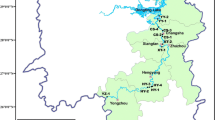Abstract
By integrating data on the chemistry, toxicity and benthic community structure, the sediment quality triad was used to evaluate the current situation of superficial sediments from the Le An River. This river has been strongly polluted with large amounts of copper, lead and zinc in waste water discharging from riparian mining and smelting activities. The response of the benthic environment was illustrated by ratio-to-reference (RTR) scale in corresponding triaxial graph. From upstream to downstream, the response intensity of three components showed sectional characteristics. The upstream area was relatively clean due to less disturbance. Within the middle stream area, extreme toxicity and serious deterioration of the benthic community structure could be mainly ascribed to strong acidity in drainage and high concentrations of multiple metals in superficial sediments, especially copper. Because of the river self-purification capability, pollution gradually declined and the sediment quality began to recover downstream. The situation was closely associated to the distribution of major pollution sources, therefore, source control and dredging operation on contaminated sediments in the middle stream area are required urgently.
Similar content being viewed by others
REFERENCES
Adams, W. J. Kimerle, R. A. and Barnett Jr., J. W.: 1992, Environ. Sci. Technol. 26, 1865.
Alden III, E. W.: 1992, Environ. Toxicol. Chem. 11, 637.
Ankley, G. T. Schubauer-Berigan, M. K. and Dierkes, J. R.: 1991, Sediment Toxicity Identification Evaluation: Phase I (characterization), Phase II (identification) and Phase III (confirmation)
Modifications of Effluent Proceduresa, EPA 600-6-91-007, Duluth MN, Technical Report 08-91, Office of Development, National Effluent Toxicity Center.
Ankley, G. T., Di Toro, D. M., Hansen, D. J. and Berry, W. J.: 1996, Environ. Toxicol. Chem. 15, 2056.
Brumbaugh, W. G., Ingersoll, C. G., Kemble, N. E., May and Zajicek, J. L.: 1994, Environ. Toxicol. Chem. 13, 1971.
Canfield, T. J., Kemble, N. E. and Brumbaugh, W. G.: 1994, Environ. Toxicol. Chem. 13, 1999.
Carr, R. S., Chapman, P. M. and Howard, C. L.: 1996, Ecotoxicol. 5, 341.
Chapman, P. M.: 1989, Environ. Toxicol. Chem. 8, 589.
Chapman, P. M.: 1990, Sci. Total Environ. 97/98, 815.
Chapman, P. M., Power, E. A. Dexter, R. N. and Anderson, H. B.: 1991, Environ. Toxicol. Chem. 10, 407.
Chapman, P. M.: 1995, J. Aquat. Ecosystem Health. 4, 183.
Chapman, P. M., Paine, M. D. and Arthur, A. D.: 1996, Mar. Pollut. Bull. 32, 47.
Chapman, P. M.: 1996, Ecotoxicol. 5, 327.
Dai, Z. H., Starke and R. Kleeberg, R.: 1994, China Environ. Sci. 5, 129.
Di Toro, D. M., Mahony, J. D., Hansen, D. J., Scott, K. J., Hicks, M. B., Mayr, S. M. and Redmond, M. S.: 1990, Environ. Toxicol. Chem. 9, 1487.
Håkanson, L.: 1980, Water Res. 14, 975.
He, M. C., Wang, Z. J. and Tang, H. X.: 1997, Science Total Environ. 206.
He, M. C., Wang, Z. J. and Tang, H. X.: 1998, Water Res. 32, 510.
Kemble, N. E., Brumbaugh, W. G., Bruson, E. L., Dwyer, F. J., Ingersoll, C. G. Monda, D. P. and Woodward, D. F.: 1994, Environ. Toxicol. Chem. 13, 1985.
Leonard, E. N., Ankley, G. T. and Hoke, R. A.: 1996, Environ. Toxicol. Chem. 15, 2221.
Mao, M. Z.: 1996, ‘Speciation of Metals in Sediments Along the Le An River’, In the Final Report of the Cooperative Ecological research Project (CERP), UNESCO, pp. 55–57.
Tang, H. X., Wang, Z. J., Liu, J. Y. and Müller, G.: 1994, China Environ. Sci. 5, 97.
Wang, H. J. and Tang, H. X.: 1994, China Environ, Sci. 5, 165.
Wang, Z. J., Ma, M., Du, Q. and Wen, X. H.: 1994, China Environ. Sci. 5, 159.
Washington, H. G.: 1984, Water Res. 18, 653.
Zhou, Y. X. and Zhang, Z. S.: 1989, Experimental Methods for Toxic Assessment of Aquatic Biota, China Agricultural Publisher, Beijing, pp. 3–190.
Zhu, J. and Ren, S. Z.: 1994, China Environ. Sci. 5, 177.
Zhu, W. J., Wang, J. and Chen, X. Y.: 1994, Ocean and Limnology (China) 25, 273.
Author information
Authors and Affiliations
Corresponding author
Rights and permissions
About this article
Cite this article
Liu, W., Luan, Z. & Tang, H. Use of the Sediment Quality Triad to Assess Metal Contamination in Freshwater Superficial Sediments from the Le An River, China. Water, Air, & Soil Pollution 113, 227–239 (1999). https://doi.org/10.1023/A:1005091504586
Issue Date:
DOI: https://doi.org/10.1023/A:1005091504586




